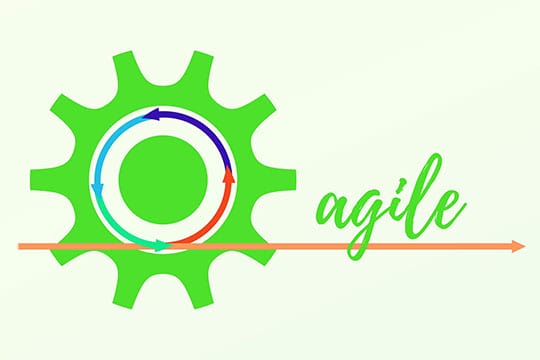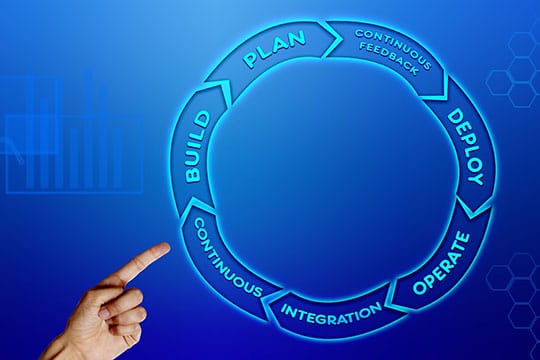Mobile applications have gained huge momentum through mobile-first strategies from enterprises around the world. With the user-base of mobile devices increasing and application downloads that are increasing the overall revenue, app development is the most successful business today. But whatever business you may be in, speeding up production is the most critical point, and with quality and cost at the center-stage, each move you make needs to be towards a faster and yet smarter production.
Total app revenue in 2019 is $461.7 billion and is expected to rise to $935.2 billion by 2023, and with 3.2 billion smartphone users as of in 2019 and 194 million app downloads in 2018, applications are at the top of the technology market and are leading the way. To achieve better application performance and faster development lifecycles, the agile approach can render good results.
What is Agile?

Agile methodologies use an iterative approach to break down the process of application development into small iterative components. This iterative approach reduces the risks and allows the process to adapt to modifications easily and with no demand for upfront requirements. The agile approach for application development consists of iterative and incremental strategies involving self-organizing teams and cross-functioning teams working in a collaborative environment.
Scrum and XP are the commonly used agile approaches for application development as of now. Scrum is more focused on project management, and firms are looking for disciplined and limited mobile application scope look to adopt the Scrum methodology. Many mobile companies and even individual developers look towards Scrum for app development that is of high-end user interaction and a condensed time-to-market paradigm.
As far as the technical aspect of agile is concerned, Extreme Programming (XP) helps organizations achieve high-quality applications. It relies on approaches like Behavior Driven Development (BDD), Continuous Integration (CI), and Test-Driven Development (TDD) for infusing high-performance design, seamless integration of versions, and error-free development.
There are many other approaches than Scrum and XP, like Lean, Kanban, and DSDM (Dynamic systems development method) or FDD (Feature-Driven Development). All of them have one or the other characteristics of an agile approach. Selecting one methodology over the other depends on the organizational structure, application scale, and development team’s knowledge of a particular approach. To achieve success in an agile approach, each player should be in sync with the importance of predefined parameters.
Recommended for you: Continuous Processes Serve as The Foundation of DevOps.
Why choose Agile for your application development?

There are certain circumstances to be held before you say no to an Agile methodology or wonder why to choose it for your app:
Enhanced User Experience (UX):
 Applications are run in a restricted environment and have hardware constraints of mobile devices. If it takes too long for applications to respond or download, users tend to look for other options and leave your app. Agile helps you by making the user experience more flexible and enhanced through several options through sprints and iterations, only to adjust those feedbacks to provide the good end product.
Applications are run in a restricted environment and have hardware constraints of mobile devices. If it takes too long for applications to respond or download, users tend to look for other options and leave your app. Agile helps you by making the user experience more flexible and enhanced through several options through sprints and iterations, only to adjust those feedbacks to provide the good end product.
Requirement Management:
 Mobile applications have very little turnaround time and have constraints of budgets and deadlines. The prior requirements of an application are uncertain, incomplete, unclear, and constantly change during the development process. Developers often put a beta version with limited features to test the initial responses and requirements, and this is the same as Agile methods to optimize the application development process through iterations.
Mobile applications have very little turnaround time and have constraints of budgets and deadlines. The prior requirements of an application are uncertain, incomplete, unclear, and constantly change during the development process. Developers often put a beta version with limited features to test the initial responses and requirements, and this is the same as Agile methods to optimize the application development process through iterations.
Experimentation and Adaptation:
 Continuous experimentation and adaptation of feedbacks into the application are done throughout the development lifecycle. This aspect of application development can be better managed through the agile approach.
Continuous experimentation and adaptation of feedbacks into the application are done throughout the development lifecycle. This aspect of application development can be better managed through the agile approach.
Risk Management:
 Due to the tight schedule of the development process and low turnaround time, there is always a risk involved in the application being delivered to the users. An agile approach can help overcome this issue through better visibility to the customers early on with shorter iterations and sprints, and with integrations of the user feedbacks and requirements into further iterations, the agile approach reduces the risk level of application development.
Due to the tight schedule of the development process and low turnaround time, there is always a risk involved in the application being delivered to the users. An agile approach can help overcome this issue through better visibility to the customers early on with shorter iterations and sprints, and with integrations of the user feedbacks and requirements into further iterations, the agile approach reduces the risk level of application development.
Short Development Lifecycle:
 Mobile applications are developed into a restricted timeframe with shorter development lifecycle constraints. Often a smaller and leaner version of the application through the minimum viable product approach is designed by the developers with limited features, and then additional features are added later with further versions, and such a development lifecycle approach can be successfully supported through agile.
Mobile applications are developed into a restricted timeframe with shorter development lifecycle constraints. Often a smaller and leaner version of the application through the minimum viable product approach is designed by the developers with limited features, and then additional features are added later with further versions, and such a development lifecycle approach can be successfully supported through agile.
User Engagement: With an agile approach, the visibility of the users is improved, and they can closely keep regular tabs on the upcoming versions and even engage in the enhancement and improvement of further iterations. Thus, customer engagement is ensured throughout the application development lifecycle.
Agile methods that can power your application development

Mobile-D:
 This approach is based on XP (Extreme Programming), Crystal methodologies, and Rational Unified Process (RUP) and is widely used by small, collocated teams working on short development cycles. Mobile-D has five phases Explore – Initialize – Productionize – Stabilize – System Test and Fix. Each of these phases has several associated stages, tasks, and practices.
This approach is based on XP (Extreme Programming), Crystal methodologies, and Rational Unified Process (RUP) and is widely used by small, collocated teams working on short development cycles. Mobile-D has five phases Explore – Initialize – Productionize – Stabilize – System Test and Fix. Each of these phases has several associated stages, tasks, and practices.
All the phases of Mobile-D approach have nine core elements to it:
- Phasing and Pacing.
- Architecture Line.
- Mobile Test-Driven Development.
- Continuous Integration.
- Pair Programming.
- Metrics.
- Agile Software Process Improvement.
- Off-Site Customer.
- User-Centered Focus.
Through the Mobile-D approach, increased progress visibility, early identification and solving of technical problems, shared responsibility, efficient information sharing, high process practice coherence, the low defect density in released products, and constant development rhythm can be achieved.
You may like: Mobile App Development: Native App vs. Web App vs. Hybrid App.
HME (Hybrid Method Engineering):
 It combines two major agile approaches to form a single engineering-based approach. ASD (Adaptive Software Development) and NPD (New Product Development) are the two agile methods combined for HME. It is a four-iteration method with the first iteration released by using common agile approaches; the second iteration has been released using the NPD approach, which is a process of entering and introducing a new product into the market.
It combines two major agile approaches to form a single engineering-based approach. ASD (Adaptive Software Development) and NPD (New Product Development) are the two agile methods combined for HME. It is a four-iteration method with the first iteration released by using common agile approaches; the second iteration has been released using the NPD approach, which is a process of entering and introducing a new product into the market.
The third iteration is released using the ASD approach by quickly and effectively adapting to the changing requirements, and the market needs to adjust its products with lightweight planning and continuous learning. The fourth and final iteration is based on prototyping, allowing the team to develop a risk-free application. Though this is an abstract approach, it can still be practically used with effective planning and scheduling.
MASAM:
 MASAM stands for Mobile Application Software Agile Methodology. This approach provides support for application development on mobile platforms. It is based on Extreme Programming, Agile Unified Process, and other agile meta-models. There are four phases to the simple development cycle that can be achieved through this approach-Preparation Phase-Embodiment Phase-Product developing Phase-Commercialization Phase.
MASAM stands for Mobile Application Software Agile Methodology. This approach provides support for application development on mobile platforms. It is based on Extreme Programming, Agile Unified Process, and other agile meta-models. There are four phases to the simple development cycle that can be achieved through this approach-Preparation Phase-Embodiment Phase-Product developing Phase-Commercialization Phase.
The preparation phase defines a summary and a first notion of the product and assigns roles and tasks, while the embodiment phase focuses on understanding the user’s needs and defines the architecture of the application. The developing product phase follows the principles of extreme programming by using test-driven development, pair programming, refactoring, and continuous integration with a closed-loop to the iterative testing tasks and focus on the product launch and sales.
SLeSS:
 It is an integration of Scrum and Lean Six Sigma used for real projects in the development of embedded software and application customizations. This approach helps development teams to achieve higher performance and quality targets by the progressive improvement of the development process and outcome of the sprints.
It is an integration of Scrum and Lean Six Sigma used for real projects in the development of embedded software and application customizations. This approach helps development teams to achieve higher performance and quality targets by the progressive improvement of the development process and outcome of the sprints.
Challenges towards agile adaptation

- Organizations and enterprises are concerned by the lack of documentation of projects.
- There is a fear of loss of management controls and a lack of regulatory compliance.
- Lack of technology and tools for the adoption of an approach.
- The Lack of interest by the development teams to adopt a new methodology.
- Lack of needed architecture for the adoption of agile methodology.
- Not enough customer relationship exposure to introduce the methodology.
- Organizational rules and regulations as the barriers to adaptation.
Benefits of Agile

- It improves the overall performance of the applications being developed.
- It enhances the user experience by regular integration of user feedback.
- Agile approaches help break down the complex process of application development into simpler forms.
- It helps achieve faster and leaner apps through improvised iterations.
- Budget and scheduling concerns can be managed through agile.
- It ensures application testing and integration of features.
You may also like: Best Programming Language for iOS App Development.
Conclusion

The mobile application realm has grown to new heights, and more innovations can be seen in the way application are developed. For market feasibility and higher revenues, it is necessary for businesses to understand the importance of apps that are lighter and need less time to be downloaded and use lower memory footprint. All of which can be achieved by effective use of the agile approaches into the application development process.
Enterprises around the world like Lego and Cisco have used the agile methodology to restructure their products and enhance user experiences with higher productivity. Agile methods like Scrum are quite popular among high-level organizations that need higher control over the project and use the project management feature of Scrum to enhance their applications.
Other popular agile approaches have already begun to change the application development ecosystem. A developmental process of the successful version that enhances the applications and its features with each new release can be now easily achieved through an agile approach.
This article is written by Manoj Rupareliya. Manoj is an experienced writer working at AppEmporio possessing expertise in writing on technical, financial, and digital marketing niches and provides excellent guidance to hire developers and covers essential aspects for beginners to learn and develop skills for brighter future. Follow him: LinkedIn | Twitter.





